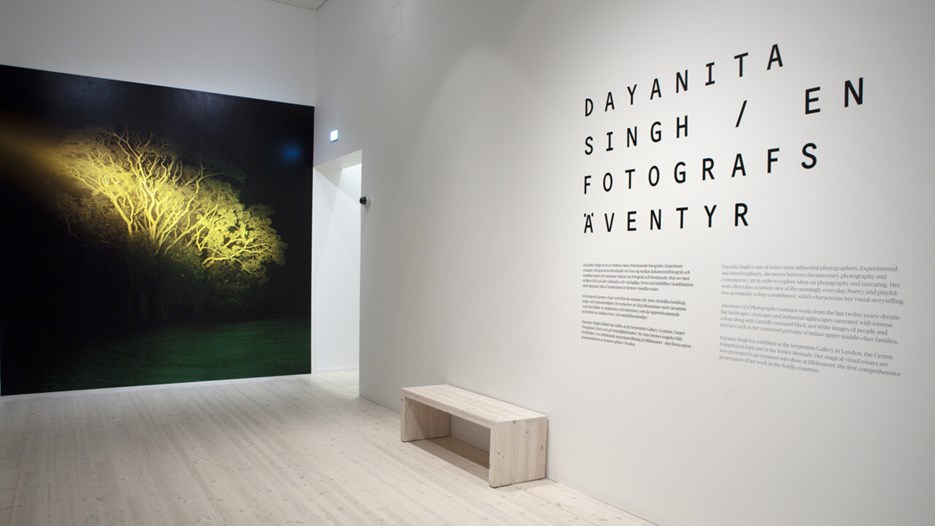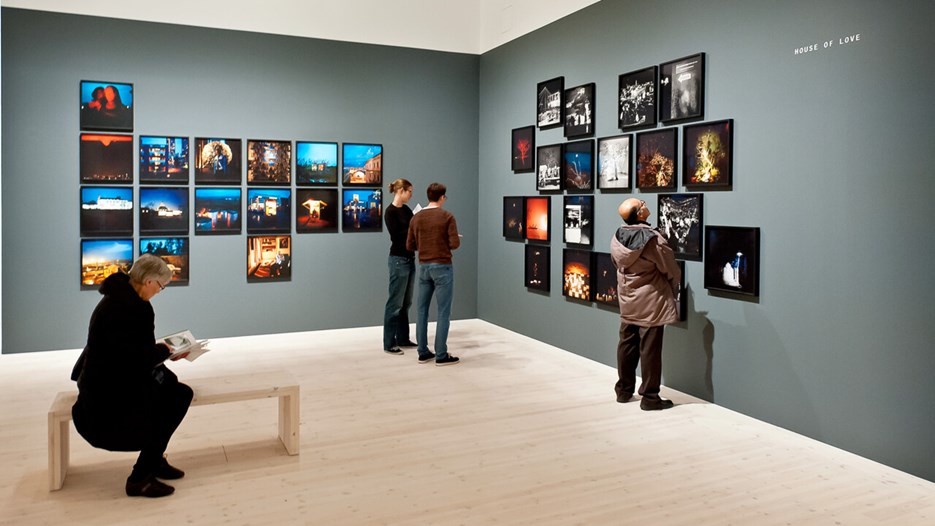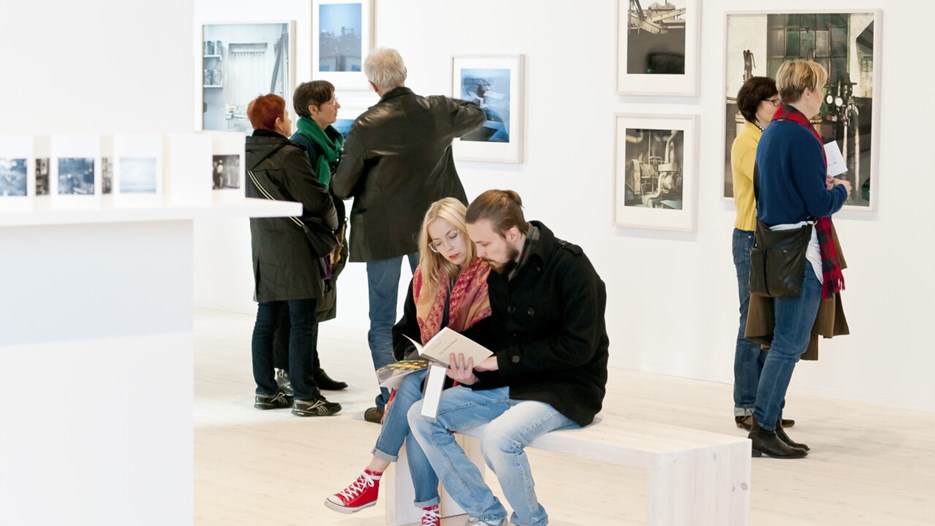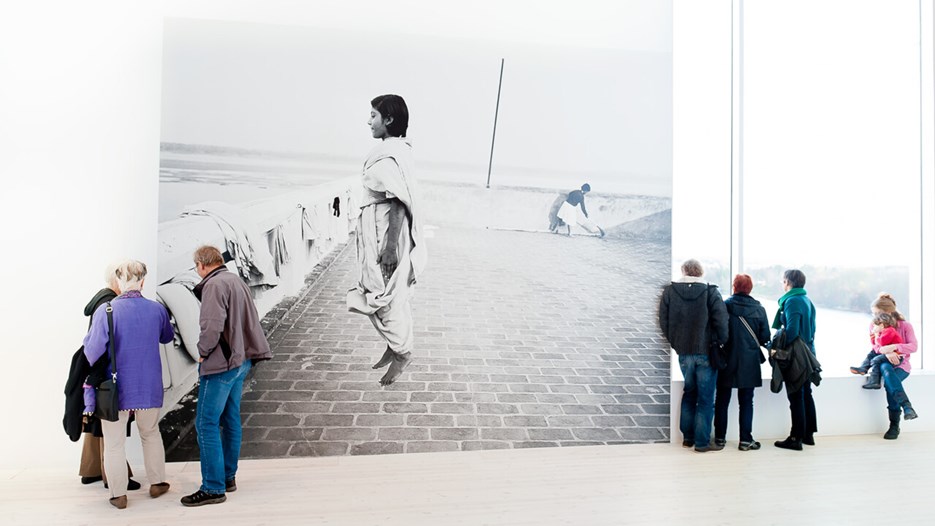
Dayanita Singh / The Adventures of a Photographer. From the exhibition at Bildmuseet 2012-2013.

Dayanita Singh / The Adventures of a Photographer. From the exhibition at Bildmuseet 2012-2013.

Dayanita Singh / The Adventures of a Photographer. From the exhibition at Bildmuseet 2012-2013.

Dayanita Singh / The Adventures of a Photographer. From the exhibition at Bildmuseet 2012-2013.
Dayanita Singh is one of India's most influential photographers. Her magical, probing and elusive visual essays are now presented in an extensive solo show at Bildmuseet, the first comprehensive presentation of her work in the Nordic countries.
Experimental and interdisciplinary, she has moved between documentary photography and contemporary art in order to explore ideas on photography and narration. Her work often takes a curiously unsettling view of the everyday. Poetry, playfulness and surprise accompany a deep commitment to the medium of photography, which characterizes her visual storytelling. The Adventures of a Photographer comprises works from the last twelve years: dreamlike landscapes, cityscapes and industrial nightscapes saturated with intense colour along with carefully executed black and white images of people and interiors such as her renowned portraits of Indian upper-middle-class families and her latest project File Room.
A question central to Dayanita Singh, and one that she keeps returning to is: What is there to photograph in India, if not disasters or the exotic? In her artistic practise she has repeatedly questioned and ruptured the media imagery that has phantomised India. She insists photography is a subjective expression, an individual project, and cannot be reduced to nationality, gender or culturally specificity. How her relationship to the photographic medium has changed over time can be read through the different works in the exhibition. Through a strong sense of integrity and an explorative approach she has developed an enduring language and a visual expression of her own that takes us into the realm of the unexpected. Books and bookmaking are an integral part of this process and a dynamic part of Dayanita Singh's artistic practice as a photographer.
Dayanita Singh (b. 1961) is based in New Delhi. She has exhibited at the Serpentine Gallery in London, the Centre Pompidou in Paris and at the Venice Biennale. Together with Ai Weiwei, Romuald Karmakar and Santu Mofokeng she has been invited to represent Germany in the national pavilion at the Venice Biennale 2013.
The exhibition Dayanita Singh / The Adventures of a Photographer is curated by Katarina Pierre, Director Bildmuseet. Assistant curator: Polly Yassin.
Dayanita Singh / The Adventures of a Photographer is exhibited at Bildmuseet October 14 - December 2, 2012.
After studying at The International Center of Photography (ICP) Dayanita Singh begun working as a photojournalist. She describes how she returned to India with ideas about changing the world through photography.
"I started photographing all the desperate social situations of India, naively believing that my photographs could make a difference to, let's say, the lives of prostitutes with AIDS. But Meherunissa, the child prostitute I photographed over 2 years, died anyway. The photographs were published extensively, but after some years I felt I could not go on earning a living from the distress of others."
It took her two years to understand that she was not comfortable with photojournalism. She then turned the camera to her own world and started photographing her friends and their families, and developed this approach into a long term project that culminated into the photographic series Ladies of Calcutta, Bombay Portraits, Allahabad Series and the book Privacy.
Another turning point in her career was her encounter with Mona Ahmed, which resulted in Myself Mona Ahmed, a mix of biography, autobiography and fiction. It was Mona Ahmed's own refusal to be the subject of a photojournalistic project that pushed Dayanita Singh into producing a different form of narrative. The book weaves together photography and literature in the unfolding of a life, which is the story of an inward journey resonant with echoes and reflections of a relationship rather than the documentary account of a different social reality.
Dayanita Singh's more recent photographic work operates as novels or poems with little traces of the documentary project. She presents a state of mind, a sentiment or an emotion and avoids describing an actual place or event. Her works are open narratives that invite us to take an active part in completing the story ourselves using personal associations, memories and experiences. She frequently reintroduces or recycles the same image by combining it with other images, entangling our acceptance of reality and truth, thereby creating new stories, fables and narratives.
In weaving her visual narrative Dayanita Singh works carefully with editing, sequencing and phrasing and rhythm. She describes how literature and music have shaped her ideas around photography. She is fascinated by the creative possibilities of writing and looks to writers to explore how they reflect upon things, on what they leave out, and how they develop the gaps and silences, the unsaid but suggested, to create a narrative. Dayanita Singh is constantly looking for ways to transform her photographic practice suggesting that photography is never enough for photographers, and photography needs to be developed in relation to other artistic practices.
"I am very interested in how far one can push photography and the overlap it has with literature. The kind of photography I am interested in needs to look to the other forms now; to cinema, to literature, to music, to create something more."
The title of the exhibition The Adventures of a Photographer comes from an essay in Italo Calvino's Difficult Loves, a text that has served as an important inspiration for Dayanita Singh's work. Another example of her on-going dialogue with literature is her work Museum of Innocence, made in response to Orhan Pamuk's novel with the same name. File Room, her latest project to date, is an elegy to paper. As an analogue photographer and an obsessive bookmaker she has developed a unique relationship with paper as an expression of memory. File Room is itself an archive of archives, a project that meditates on the nature of paper as a symbol of a society's efforts to remember and a challenge to photography's investment in the visible.
Dayanita Singh / The Adventures of a Photographer
Bildmuseet October 14, 2012 - January 13, 1013
Myself Mona Ahmed (1990-2000)
In 1989 Dayanita Singh received a commission from the Times in London to document the reality of the hijras in India, a third gender with no legal rights and living in social exclusion. It was then that she met Mona Ahmed, who became her sitter, friend, and confidante for years to come. Even though Mona initially agreed to be photographed, she would later change her mind - fearing her family's reaction if they saw the pictures - and asked Dayanita to give her the film in order to destroy it. The photographer concurred but as a result she was able to continue photographing Mona Ahmed for the next thirteen years - a work she would eventually publish with Mona's consent and cooperation in a book entitled Myself Mona Ahmed, which featured Dayanita's photographs and an autobiographical text by Mona that blends reality and fiction in the form of her correspondence with the Swiss publisher.
I am as I am (1999)
Another work that signals Dayanita Singh's transition from photojournalism to a more personal approach to photography is I am as I am, a series that focuses on the everyday life of the girls who live in an ashram in Benares, a Hindu monastery where days are spent absorbed in classes, meditation, games and work. The girls hardly ever set foot outside their ashram until they are of age, at which time they must decide whether they wish to stay, and live the rest of their lives in renunciation of the material world.
Benares has become an icon for Hindu India. It is known throughout the world as a pilgrimage destination and for the religious incineration rituals celebrated on the banks of the river Ganges. Yet, the theme chosen by Singh shows another Benares, a private setting that contrasts with the city's public nature: a female ashram, which is a paradox in itself, a graceful and lucid environment. One of Dayanita Singh's best-known photographs belongs to this series. It shows a girl who seems to levitate, floating weightlessly in the air.
Ladies of Calcutta (1997-2002)
Allahabad Series (2000)
Bombay Portraits (2002)
After having spent many years documenting the poverty in her homeland Dayanita Singh returned to the world from which she came, to India's extended, well-to-do families and their fine homes. Both on commission and on her own, she photographed friends and friends of friends, creating a portrait of another society, and providing great insight into a closed world characterized by tight family solidarity. Dayanita Singh shows the people as they would like to see themselves, in the middle of splendidly decorated rooms and surrounded by their possessions. Conveying mood, relationships and affections in one snap of time. There is history in each frame - culture, tradition and age - as reflected in the way the women pose, the clothes they wear, the furniture, even the pictures on the walls.
At a certain point in her work Dayanita Singh realized that even without their residents, the rooms were occupied by the invisible generations that had lived there before. She started making photographs of interiors, empty but still filled with spirits.
"I realized that I could make portraits without a person in it. I started to make photographs of spaces without human beings, yet peopled by the unseen generations who had lived there before. Very soon I was consumed by this seeming emptiness: beds of those who had passed away, but that were still made everyday, beds turned into shrines with photos and sandals on them, and of course the beds of the living, but without their physical presence."
Dayanita Singh started photographing her friends in Bombay and Calcutta. When the show opened in Stephen Court in January 2008, there were friends and friends of friends who had opened their homes and lives to her. And Dayanita Singh's thank you gift for her subjects - each was allowed to take home the photograph she had made of them until the exhibition space was completely empty. The book Privacy was a work in progress of this long-term project.
Interior Landscapes (2005)
Interior Landscapes was developed in conversation with Dayanita Singh's friend and writer Aveek Seen in Calcutta. She had just made an exhibition on landscapes but felt that something missing. Twenty years before she had photographed people in a psychiatric ward but decided not to use the images as she felt there were too exploitive. By combining both series, she juxtaposed two approaches and turned the story into something else.
Go Away Closer (2007)
Go Away Closer is a novel without words. It concerns series of opposites: intimacy and solitude, presence and absence, reality and dreams. Dayanita Singh embraces these paradoxes and invites the viewer to read his or her own biography. She establishes a connection between personal losses, and the collective sadness, a grief due to lost traditions in the face of a changing society.
Dayanita Singh describes this project as her most important moment. The series signals a clear departure from documentary photography. For the first time this was a project with no documentary ambitions, but a project based on an emotion. A point of departure was the photograph with the girl on the bed that triggered emotions of solitude, departure, recollections and loss - important emotions and not necessarily Indian ones. Dayanita Singh fully realized herself as the author and in control of the narrative. Photography is an international language, a language which also is hers.
Sent a Letter (2008)
Dayanita Singh has been making small photographic journals of her travels in India for some years now. Each book is made with a certain person in mind, either one she has made the journey with or one who was on her mind on her travels. She makes two handmade copies, one that remains with her (she calls this her kitchen museum) and the other for the friend it was made for.
Sent a Letter contains seven of these diaries including one of Dayanita Singh's mother Nony and Singh's photographs of her daughter growing up. The diaries, presented in a handmade cloth box, are in accordion folds and open into a mini private exhibition, like a portable museum.
Blue Book (2009)
In Blue Book - Dayanita Singh's first colour project - we are confronted with industrial landscapes and a few interiors shoots of these premises. All of these photographs were taken after dusk, at twilight, when there is a colour shift. But the blue tone in the photographs is a result of the limitations of daylight film; she uses the films reactions to colour temperature and light. Blue Book marks a shift towards colour as fiction rather than fact and a freedom from documentary realism. Before Blue Book she had avoided to use colour because India has too many colours as she puts it, and she had refused to click into the standard picture of India.
The publication Blue Book is made of twenty-three postcards, which gives the reader the possibility to keep the book or to fulfill its second purpose: to communicate via these beautiful postcards.
Dream Villa (2010)
In Dream Villa Dayanita Singh explores how the night transforms what seems ordinary by day into something mysterious and unsettling. The photographs are mostly devoid of human presence. Instead, the series' vacant, quiet, anonymous spaces allow the drama of light and shadow to take centre stage. Dream Villa is not about a specific place; the photographs were taken all over India and their setting is rarely identifiable. This series of colour photographs presents a landscape, which exists as much in the artist's imagination as in the real world. Daylight film used at night reproduces colours in a different way than when used in daylight. In Dream Villa moody night skies are juxtaposed with artificial lighting. The images are formally experimental yet atmospheric and almost cinematic.
House of Love (2011)
House of Love refers to the Taj Mahal, the iconic architectural memorial to the beloved wife of the emperor Shah Jahan. Dayanita's works invites the viewer to dream of new meanings linking her photos with poetry and prose. The book House of Love is a work of photographic fiction that takes the form of nine short stories. Working closely with writer Aveek Sen, whose prose follows a journey of its own, Dayanita Singh explores the relationship between photography, memory, and writing. House of Love, is designed to blur the lines between an art book of photographic images and a work of literary fiction, it is a book whose images demand to be read, not just seen, and whose texts create their own sensory worlds.
File Room (2011)
Dayanita Singh's File Room is an elegy to paper in the age of the digitization of information and knowledge. The analogue photographer and bookmaker has a unique relationship with paper that is integral not only to the work of making of images, texts and memory, but as with File Room can also represent a confrontation with chaos, mortality and disorder in the labyrinths of bureaucracy. The endless rows of files in Indian courts, municipal offices, state archives and other such institutions for the conservation of human data create monuments to knowledge and to the arts of memory. They have their own atmosphere and architecture. File Room is itself an archive of archives, a project that reflects on the nature of paper as a symbol of a society's efforts to remember.
Museum of Innocence (2011)
The photographic series Museum of Innocence takes as its departure the Nobel Prize Laureate Orhan Pamuk's novel with the same name. Pamuk's book tells the story of a Turkey where old traditions are deserted as a consequence of violent modernisation. In the novel, the protagonist, Kemal, is obsessed by his impossible love to Füsun, and he starts collecting every single object that she has touched to create a museum in commemoration of her. In Dayanita Singh's photographic work Museum of Innocence there is also a text describing the fictious conversation between her and Kemal around collecting, passion and the tediousness of love.